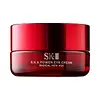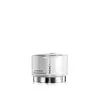What's inside
What's inside
 Key Ingredients
Key Ingredients

 Benefits
Benefits

 Concerns
Concerns

 Ingredients Side-by-side
Ingredients Side-by-side

Water
Skin ConditioningGlycerin
HumectantGalactomyces Ferment Filtrate
HumectantNiacinamide
SmoothingIsohexadecane
EmollientButylene Glycol
HumectantPentylene Glycol
Skin ConditioningIsopropyl Isostearate
EmollientPetrolatum
EmollientDimethicone
EmollientCaprylic/Capric Triglyceride
MaskingVinyl Dimethicone/Methicone Silsesquioxane Crosspolymer
Polyacrylamide
Phytosteryl/Behenyl/Octyldodecyl Lauroyl Glutamate
Skin ConditioningStearyl Alcohol
EmollientCetyl Alcohol
EmollientC13-14 Isoparaffin
EmollientBehenyl Alcohol
EmollientTocopheryl Acetate
AntioxidantPolymethylsilsesquioxane
Panthenol
Skin ConditioningNylon-12
Benzyl Alcohol
PerfumingDimethiconol
EmollientMethylparaben
PreservativePEG-100 Stearate
Laureth-7
EmulsifyingCetearyl Glucoside
EmulsifyingCetearyl Alcohol
EmollientStearic Acid
CleansingMica
Cosmetic ColorantDisodium EDTA
Propylparaben
PreservativeSodium PEG-7 Olive Oil Carboxylate
EmulsifyingEthylparaben
PreservativePEG-7 Glyceryl Cocoate
EmulsifyingChlorella Vulgaris Extract
Skin ConditioningSodium Hydroxide
BufferingHydrolyzed Lupine Protein
Skin ConditioningDecyl Glucoside
CleansingMedicago Sativa Extract
TonicPhenoxyethanol
PreservativeLactic Acid
BufferingSodium Benzoate
MaskingHydrolyzed Soy Protein
HumectantPolyquaternium-7
Tin Oxide
AbrasiveEthylhexylglycerin
Skin ConditioningPalmitoyl Dipeptide-7
Skin ConditioningHydrolyzed Yeast Protein
Skin ConditioningAcanthopanax Senticosus Root Extract
Skin ConditioningPalmitoyl Pentapeptide-4
Skin ConditioningMethylsilanol Tri-PEG-8 Glyceryl Cocoate
EmulsifyingAmmonium Polyacrylate
StabilisingMethicone
EmollientTocopherol
AntioxidantCynara Scolymus Leaf Extract
Skin ConditioningBHT
AntioxidantParfum
MaskingLimonene
PerfumingLinalool
PerfumingCI 77891
Cosmetic ColorantCI 77492
Cosmetic ColorantWater, Glycerin, Galactomyces Ferment Filtrate, Niacinamide, Isohexadecane, Butylene Glycol, Pentylene Glycol, Isopropyl Isostearate, Petrolatum, Dimethicone, Caprylic/Capric Triglyceride, Vinyl Dimethicone/Methicone Silsesquioxane Crosspolymer, Polyacrylamide, Phytosteryl/Behenyl/Octyldodecyl Lauroyl Glutamate, Stearyl Alcohol, Cetyl Alcohol, C13-14 Isoparaffin, Behenyl Alcohol, Tocopheryl Acetate, Polymethylsilsesquioxane, Panthenol, Nylon-12, Benzyl Alcohol, Dimethiconol, Methylparaben, PEG-100 Stearate, Laureth-7, Cetearyl Glucoside, Cetearyl Alcohol, Stearic Acid, Mica, Disodium EDTA, Propylparaben, Sodium PEG-7 Olive Oil Carboxylate, Ethylparaben, PEG-7 Glyceryl Cocoate, Chlorella Vulgaris Extract, Sodium Hydroxide, Hydrolyzed Lupine Protein, Decyl Glucoside, Medicago Sativa Extract, Phenoxyethanol, Lactic Acid, Sodium Benzoate, Hydrolyzed Soy Protein, Polyquaternium-7, Tin Oxide, Ethylhexylglycerin, Palmitoyl Dipeptide-7, Hydrolyzed Yeast Protein, Acanthopanax Senticosus Root Extract, Palmitoyl Pentapeptide-4, Methylsilanol Tri-PEG-8 Glyceryl Cocoate, Ammonium Polyacrylate, Methicone, Tocopherol, Cynara Scolymus Leaf Extract, BHT, Parfum, Limonene, Linalool, CI 77891, CI 77492
Phyllostachys Bambusoides Juice
Skin ConditioningCyclopentasiloxane
EmollientDimethicone
EmollientGlycerin
HumectantButylene Glycol
HumectantCyclohexasiloxane
EmollientAlcohol
AntimicrobialWater
Skin ConditioningPEG-75
HumectantPEG-10 Dimethicone
Skin ConditioningBiosaccharide Gum-1
HumectantSqualane
EmollientNiacinamide
SmoothingAcetyl Glucosamine
Skin ConditioningHydrolyzed Phyllostachys Bambusoides
HumectantHydrolyzed Camellia Sinensis Leaf
HumectantGlycine Soja Seed Extract
Skin ConditioningNelumbo Nucifera Flower Extract
Skin ConditioningOpuntia Coccinellifera Fruit Extract
Skin ConditioningHesperidin
EmollientCaffeine
Skin ConditioningTheanine
EmollientKaempferol
AntioxidantCamellia Sinensis Flower Extract
PerfumingNatto Gum
Beta-Glucan
Skin ConditioningSodium Hyaluronate
HumectantTocopherol
AntioxidantPhytantriol
HumectantEpigallocatechin Gallate
AntioxidantDisteardimonium Hectorite
StabilisingLauryl PEG-9 Polydimethylsiloxyethyl Dimethicone
Skin ConditioningPolysilicone-11
Propanediol
SolventDimethiconol
EmollientDimethicone/Vinyl Dimethicone Crosspolymer
Skin ConditioningStearyl Behenate
EmollientPolyglyceryl-3 Methylglucose Distearate
EmulsifyingHydroxypropyl Bispalmitamide Mea
EmollientInulin Lauryl Carbamate
Emulsion StabilisingPolysorbate 20
EmulsifyingPEG-15 Pentaerythrityl Tetra(Laureth-6 Carboxylate)
HumectantSodium Chloride
MaskingPoloxamer 407
EmulsifyingAmmonium Acryloyldimethyltaurate/Vp Copolymer
1,2-Hexanediol
Skin ConditioningDisodium EDTA
Ethylhexylglycerin
Skin ConditioningPhenoxyethanol
PreservativeParfum
MaskingPhyllostachys Bambusoides Juice, Cyclopentasiloxane, Dimethicone, Glycerin, Butylene Glycol, Cyclohexasiloxane, Alcohol, Water, PEG-75, PEG-10 Dimethicone, Biosaccharide Gum-1, Squalane, Niacinamide, Acetyl Glucosamine, Hydrolyzed Phyllostachys Bambusoides, Hydrolyzed Camellia Sinensis Leaf, Glycine Soja Seed Extract, Nelumbo Nucifera Flower Extract, Opuntia Coccinellifera Fruit Extract, Hesperidin, Caffeine, Theanine, Kaempferol, Camellia Sinensis Flower Extract, Natto Gum, Beta-Glucan, Sodium Hyaluronate, Tocopherol, Phytantriol, Epigallocatechin Gallate, Disteardimonium Hectorite, Lauryl PEG-9 Polydimethylsiloxyethyl Dimethicone, Polysilicone-11, Propanediol, Dimethiconol, Dimethicone/Vinyl Dimethicone Crosspolymer, Stearyl Behenate, Polyglyceryl-3 Methylglucose Distearate, Hydroxypropyl Bispalmitamide Mea, Inulin Lauryl Carbamate, Polysorbate 20, PEG-15 Pentaerythrityl Tetra(Laureth-6 Carboxylate), Sodium Chloride, Poloxamer 407, Ammonium Acryloyldimethyltaurate/Vp Copolymer, 1,2-Hexanediol, Disodium EDTA, Ethylhexylglycerin, Phenoxyethanol, Parfum
Ingredients Explained
These ingredients are found in both products.
Ingredients higher up in an ingredient list are typically present in a larger amount.
Butylene Glycol (or BG) is used within cosmetic products for a few different reasons:
Overall, Butylene Glycol is a safe and well-rounded ingredient that works well with other ingredients.
Though this ingredient works well with most skin types, some people with sensitive skin may experience a reaction such as allergic rashes, closed comedones, or itchiness.
Learn more about Butylene GlycolDimethicone is a type of synthetic silicone created from natural materials such as quartz.
What it does:
Dimethicone comes in different viscosities:
Depending on the viscosity, dimethicone has different properties.
Ingredients lists don't always show which type is used, so we recommend reaching out to the brand if you have questions about the viscosity.
This ingredient is unlikely to cause irritation because it does not get absorbed into skin. However, people with silicone allergies should be careful about using this ingredient.
Note: Dimethicone may contribute to pilling. This is because it is not oil or water soluble, so pilling may occur when layered with products. When mixed with heavy oils in a formula, the outcome is also quite greasy.
Learn more about DimethiconeDimethiconol is a silicone that resembles the popular dimethicone. Like other silicones, it is an emollient. Emollients create a thin film on skin to prevent moisture from escaping.
This ingredient helps to create a silky texture and improve spreadability. Due to its high molecular weight and thickness, it is often combined with cyclopentasiloxane.
Disodium EDTA plays a role in making products more stable by aiding other preservatives.
It is a chelating agent, meaning it neutralizes metal ions that may be found in a product.
Disodium EDTA is a salt of edetic acid and is found to be safe in cosmetic ingredients.
Learn more about Disodium EDTAEthylhexylglycerin (we can't pronounce this either) is commonly used as a preservative and skin softener. It is derived from glyceryl.
You might see Ethylhexylglycerin often paired with other preservatives such as phenoxyethanol. Ethylhexylglycerin has been found to increase the effectiveness of these other preservatives.
Glycerin is already naturally found in your skin. It helps moisturize and protect your skin.
A study from 2016 found glycerin to be more effective as a humectant than AHAs and hyaluronic acid.
As a humectant, it helps the skin stay hydrated by pulling moisture to your skin. The low molecular weight of glycerin allows it to pull moisture into the deeper layers of your skin.
Hydrated skin improves your skin barrier; Your skin barrier helps protect against irritants and bacteria.
Glycerin has also been found to have antimicrobial and antiviral properties. Due to these properties, glycerin is often used in wound and burn treatments.
In cosmetics, glycerin is usually derived from plants such as soybean or palm. However, it can also be sourced from animals, such as tallow or animal fat.
This ingredient is organic, colorless, odorless, and non-toxic.
Glycerin is the name for this ingredient in American English. British English uses Glycerol/Glycerine.
Learn more about GlycerinNiacinamide is a multitasking form of vitamin B3 that strengthens the skin barrier, reduces pores and dark spots, regulates oil, and improves signs of aging.
And the best part? It's gentle and well-tolerated by most skin types, including sensitive and reactive skin.
You might have heard of "niacin flush", or the reddening of skin that causes itchiness. Niacinamide has not been found to cause this.
In very rare cases, some individuals may not be able to tolerate niacinamide at all or experience an allergic reaction to it.
If you are experiencing flaking, irritation, and dryness with this ingredient, be sure to double check all your products as this ingredient can be found in all categories of skincare.
When incorporating niacinamide into your routine, look out for concentration amounts. Typically, 5% niacinamide provides benefits such as fading dark spots. However, if you have sensitive skin, it is better to begin with a smaller concentration.
When you apply niacinamide to your skin, your body converts it into nicotinamide adenine dinucleotide (NAD). NAD is an essential coenzyme that is already found in your cells as "fuel" and powers countless biological processes.
In your skin, NAD helps repair cell damage, produce new healthy cells, support collagen production, strengthen the skin barrier, and fight environmental stressors (like UV and pollution).
Our natural NAD levels start to decline with age, leading to slower skin repair, visible aging, and a weaker skin barrier. By providing your skin niacinamide, you're recharging your skin's NAD levels. This leads to stronger, healthier, and younger looking skin.
Another name for vitamin B3 is nicotinamide. This vitamin is water-soluble and our bodies don't store it. We obtain Vitamin B3 from either food or skincare. Meat, fish, wheat, yeast, and leafy greens contain vitamin B3.
The type of niacinamide used in skincare is synthetically created.
Learn more about NiacinamideParfum is a catch-all term for an ingredient or more that is used to give a scent to products.
Also called "fragrance", this ingredient can be a blend of hundreds of chemicals or plant oils. This means every product with "fragrance" or "parfum" in the ingredients list is a different mixture.
For instance, Habanolide is a proprietary trade name for a specific aroma chemical. When used as a fragrance ingredient in cosmetics, most aroma chemicals fall under the broad labeling category of “FRAGRANCE” or “PARFUM” according to EU and US regulations.
The term 'parfum' or 'fragrance' is not regulated in many countries. In many cases, it is up to the brand to define this term.
For instance, many brands choose to label themselves as "fragrance-free" because they are not using synthetic fragrances. However, their products may still contain ingredients such as essential oils that are considered a fragrance by INCI standards.
One example is Calendula flower extract. Calendula is an essential oil that still imparts a scent or 'fragrance'.
Depending on the blend, the ingredients in the mixture can cause allergies and sensitivities on the skin. Some ingredients that are known EU allergens include linalool and citronellol.
Parfum can also be used to mask or cover an unpleasant scent.
The bottom line is: not all fragrances/parfum/ingredients are created equally. If you are worried about fragrances, we recommend taking a closer look at an ingredient. And of course, we always recommend speaking with a professional.
Learn more about ParfumPhenoxyethanol is a preservative that has germicide, antimicrobial, and aromatic properties. Studies show that phenoxyethanol can prevent microbial growth. By itself, it has a scent that is similar to that of a rose.
It's often used in formulations along with Caprylyl Glycol to preserve the shelf life of products.
Tocopherol (also known as Vitamin E) is a common antioxidant used to help protect the skin from free-radicals and strengthen the skin barrier. It's also fat soluble - this means our skin is great at absorbing it.
Vitamin E also helps keep your natural skin lipids healthy. Your lipid skin barrier naturally consists of lipids, ceramides, and fatty acids. Vitamin E offers extra protection for your skin’s lipid barrier, keeping your skin healthy and nourished.
Another benefit is a bit of UV protection. Vitamin E helps reduce the damage caused by UVB rays. (It should not replace your sunscreen). Combining it with Vitamin C can decrease sunburned cells and hyperpigmentation after UV exposure.
You might have noticed Vitamin E + C often paired together. This is because it is great at stabilizing Vitamin C. Using the two together helps increase the effectiveness of both ingredients.
There are often claims that Vitamin E can reduce/prevent scarring, but these claims haven't been confirmed by scientific research.
Learn more about TocopherolWater. It's the most common cosmetic ingredient of all. You'll usually see it at the top of ingredient lists, meaning that it makes up the largest part of the product.
So why is it so popular? Water most often acts as a solvent - this means that it helps dissolve other ingredients into the formulation.
You'll also recognize water as that liquid we all need to stay alive. If you see this, drink a glass of water. Stay hydrated!
Learn more about Water